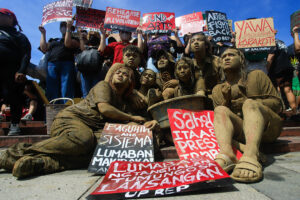As the flood control telenovela drags on, each new revelation widens the circle of suspicion. The instinct is to rage; the wiser course is restraint. Protest, but peacefully. Organizers are already calling for a “louder” anti-corruption mobilization on Nov. 30. One can only hope the anger does not spill over.
Otherwise, the cause risks being discredited by those intent on making trouble. An incident like the container burning on Mendiola on Sept. 21 shows how a legitimate grievance can turn into a law-and-order problem. It is also how a reform movement can lose support from citizens wary of chaos.
The chief of the Armed Forces of the Philippines (AFP) has urged troops to uphold the code of conduct and ignore the political noise amid fresh coup rumors. He even confirmed being approached to mount a coup. His message is that soldiers should remain professional. To reciprocate, the public must keep protests peaceful as well.
In the Senate, Senator Ping Lacson has resigned as Blue Ribbon chair in the middle of the corruption probe, fueling speculation of leadership change again, even as the chamber insists it’s “stable.” Any attempted leadership shake-up before or after recess will be read through the prism of the flood control mess.
Catholic bishops have already warned that a leadership coup would only heighten suspicion of a cover-up. The calendar doesn’t help. The Senate adjourns this week and resumes on Nov. 10. A month may be too long for rumor to outpace facts. The status quo may not appease the madding crowd.
Destabilizers now hover at the edges of the crisis, intending to ride outrage for private gain. This is why the line between anger and violence must not be crossed. When turmoil is labeled an “imminent threat,” police lines harden, the military is put on standby, and a just cause is reduced to a security problem.
The burden is now squarely on the state to keep investigations credible, free of interference, and quickly moving toward publicly acceptable resolutions. Instability is cancer to an economy already breathing second-hand smoke from global conflicts. Investors price risk faster than courts produce verdicts.
Before the Senate’s Nov. 10 return, and well ahead of the Nov. 30 protest, there should be visible case movement. Citizens, for their part, should keep pressure high and protests peaceful. People must not conclude that the campaign is selective, or stalls at the edge of the real culprits.
Cooler heads, not unfettered adventurism, must prevail and keep the country in the right direction. There will be short-term political volatility, but institutional fracture remains low with the AFP signaling discipline and the Senate leadership projecting stability. Extra-constitutional change remains at bay.
That is, unless violence escalates or the ongoing probe begins to look like a political purge instead of a cleanup. Peace without progress will not hold. The cure is the same as the promise: strong action against the guilty, level-headedness in the streets, and reforms that outlast the news cycle.
Discontent rarely arises from a single trigger. It builds when multiple pressures converge: economic hardship, political distrust, and social anxiety feeding off one another until the atmosphere turns combustible. We must guard against this convergence of discontent.
With food inflation, families already grapple with shrinking grocery baskets. Transport woes compound the misery with commuters grinding through long lines and enduring bad service. More households face skipped meals and unpaid bills. Add to this the drag of global uncertainty.
Each is a stress point. Together, they create an undercurrent of grievance too powerful to ignore. But the economy alone does not explain the current mood. Political anger has also been supercharged by corruption scandals that name senators, congressmen, and Public Works officials.
When economic distress and political discontent intersect, the tipping point becomes closer. Protests are no longer just about one project or one scandal. They are about a system seen as exploitative, self-serving, and tone-deaf to the people’s struggles. Each rally, each viral exposé, adds heat to the tinder. Without careful leadership, the flame could spread.
We have seen convergence before. In 1972, President Ferdinand Marcos, Sr. declared martial law, citing bombings, insurgency, and political paralysis. But underneath the rhetoric was a society strained by inflation, student unrest, and elite feuds. Economic anxiety and political unrest led to an authoritarian “cure.”
In 1983, the assassination of Ninoy Aquino ignited a long fuse. By 1986, economic hardship, a debt crisis, unemployment, and bread-and-butter discontent met the fury of a stolen snap election. This convergence fueled People Power at EDSA. The armed forces fractured, and the dictatorship fell.
In 2001, President Joseph Estrada’s impeachment trial was aborted amidst public disgust at corruption. People went to EDSA once more. The Cabinet resigned. The business elite and Church called for his ouster. The military and police defected and shifted allegiance to the vice-president. Once the political establishment walked away, his presidency collapsed.
Today’s climate bears echoes of all three: economic strain and political unrest like 1972; economic hardship and political outrage like 1986; and disgust at corruption and frustration at elite impunity like 2001. The difference is that the armed forces remain disciplined, and the President himself exposed the anomalies.
The country cannot afford a repeat. Instability is poison to an economy already weakened. Investors flee uncertainty faster than they flee high interest rates. Ordinary workers suffer more than public officials accused. The nation pays in lost jobs, in higher prices, in slower growth.
The antidote is political will, evidenced by strong, credible action against the guilty, anchored in due process. No sacred cows, no selective justice. The guilty must be punished, but in a manner that strengthens, not undermines, institutions. The government must assure the public that anger is valid, but violence is self-defeating. Protest, yes. Pressure, yes. But always within the bounds of law.
Convergence may occur, as economic discontent and political rage feed one another. For now, the fire can still be contained, but only if the government matches bold words with visible action. Justice delivered firmly and fairly can cool tempers, restore faith, and turn a moment of peril into a chance for reform.
The threat of extra-constitutional regime change may be low, but it is not negligible. The convergence of economic distress and political anger is combustible, but still containable at this point. Leaders need to show will, transparency, and, most of all, restraint to keep to what is in the best interest of the country.
Marvin Tort is a former managing editor of BusinessWorld, and a former chairman of the Philippine Press Council.
matort@yahoo.com

